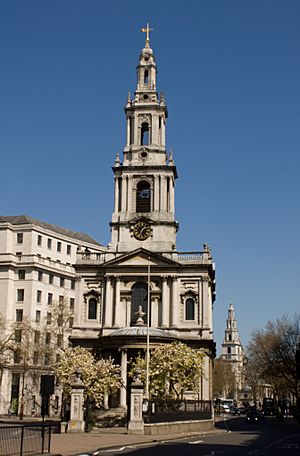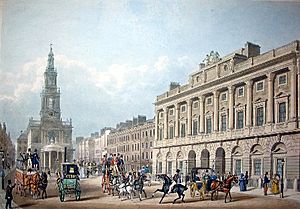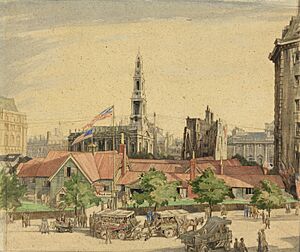St Mary le Strand facts for kids
Quick facts for kids St Mary le Strand |
|
|---|---|

St Mary le Strand seen from the west (prior to pedestrianisation in 2021)
|
|
| Location | Strand, City of Westminster WC2R 1ES, London |
| Country | England |
| Denomination | Church of England |
| Churchmanship | Liberal Catholic |
| Website | www.stmarylestrand.com |
| History | |
| Dedicated | 1724 |
| Architecture | |
| Heritage designation | Grade I |
| Architect(s) | James Gibbs |
| Years built | 1714–1724 |
| Administration | |
| Archdeaconry | Archdeaconry of London (previously Charing Cross) |
| Diocese | Diocese of London |
St Mary le Strand is a beautiful Church of England church in London, England. You can find it at the eastern end of the Strand street in the City of Westminster. This church is special because it used to be on a traffic island, right in the middle of a busy road!
It's located near famous places like Somerset House and King's College London. Even though there were older churches here before, the current building was part of a big project in the early 1700s to build many new churches. St Mary le Strand is also the official church for the Women's Royal Naval Service. They have a special book there to remember members who have passed away. It's known as one of London's two 'Island Churches', the other being St Clement Danes.
Contents
The Church's Story
Early Beginnings
St Mary le Strand is actually the second church with this name. The first one was a bit further south. We don't know exactly when it was built, but it was mentioned in a document from 1222. Back then, it was called the Church of the Innocents, or St Mary and the Innocents.
Sadly, this first church was torn down in 1549. This happened because Edward Seymour, 1st Duke of Somerset wanted to build Somerset House. The people who went to the church were promised a new one, but it was never built. So, they had to go to nearby churches like St Clement Danes or the Savoy Chapel.
Building the New Church
The spot where the current church stands used to have a very tall maypole. This was a place for fun May Day parties in the 1500s and 1600s. But by the early 1700s, the maypole was old and falling apart.
The new St Mary le Strand was the very first of twelve new churches built in London. This project was part of a plan called the "Commission for Building Fifty New Churches." It cost about £16,000 to build, which was a lot of money back then!
Construction started in February 1714. The architect was James Gibbs, and this was his first big project after coming back from Italy. The tall steeple was finished in September 1717. However, the church wasn't ready for services until January 1, 1724. Edmund Gibson, who was the Bishop of London, officially opened it.
Famous Connections
Many interesting things have happened at St Mary le Strand. It's said that Bonnie Prince Charlie gave up his Roman Catholic faith here in 1750. He supposedly became an Anglican during a secret visit to London.
Also, in 1809, the parents of the famous writer Charles Dickens got married in this church. Their names were John Dickens and Elizabeth Barrow.
Restoration and Survival
In 1871, the church was updated by Robert Jewell Withers. He changed the old box pews into the elegant benches you see today. He also added the beautiful tiled floor in the main part of the church. These changes were very popular and are still there.
The church almost got destroyed twice in the 1900s. Early in the century, there was a plan to knock it down to make the Strand wider. But artists like Walter Crane helped save it. Even though the church was saved, its graveyard was removed, and the graves were moved to another cemetery.
During the Second World War, London was bombed a lot in what was called the London Blitz. Many buildings around the church were damaged, but St Mary le Strand managed to survive, even though a nearby bomb did cause some damage.
Church Design
Architectural Style
The design of St Mary le Strand was quite talked about from the very beginning. The architect, James Gibbs, later said he wasn't happy with how his plans were changed. He originally wanted the church to look more Italian, with a small bell tower and no tall steeple.
Instead of a steeple, there was a plan for a very tall column, about 76 meters (250 feet) high, with a statue of Queen Anne on top. A lot of stone was bought for this column. But Queen Anne died in 1714, and the plan was dropped. Gibbs was then told to use the stone to build a steeple instead. This completely changed the church's original design.
Gibbs explained that because the church was already partly built, he couldn't change its length. So, he had to make it wider from north to south, which made the church's shape long instead of square.
Exterior and Interior Details
Some people at the time thought the fancy Baroque decorations on the outside were too much. Once, in 1802, one of the decorative urns on the church fell off and sadly killed someone passing by.
The church's location, right in the middle of a busy area, has always been a challenge. Even in the 1700s, people complained about the traffic noise. Because of this, Gibbs designed the ground floor without windows to help keep the noise out.
Despite some criticisms, this church was Gibbs's first public building and made him very famous. The inside of the church is beautifully decorated with a white and gold plastered ceiling. The ceiling design was inspired by famous Italian artists. The church's entrance porch was also inspired by Italian architecture. The walls show influences from Michelangelo, and the steeple was inspired by Sir Christopher Wren.
Rectors of St Mary le Strand
- 1724–1759 John Heylyn
- 1759–1761 Charles Tarrant
- 1761–1777 Charles Bertie
- 1777–1780 John William Hopkins
- 1781–1812 James Robinson Hayward
- 1813–1839 James Edward Gambier
- 1839–1861 Joshua Frederick Denham
- 1861–1878 Alfred Bowen Evans
- 1878–1891 Lewen Tugwell
- 1891–1944 Frederick Harcourt Hillersdon
- 1944-1966 Bertram Francis Chambers
- 1984 Edward Thompson
- 2005 William Gulliford
See also



